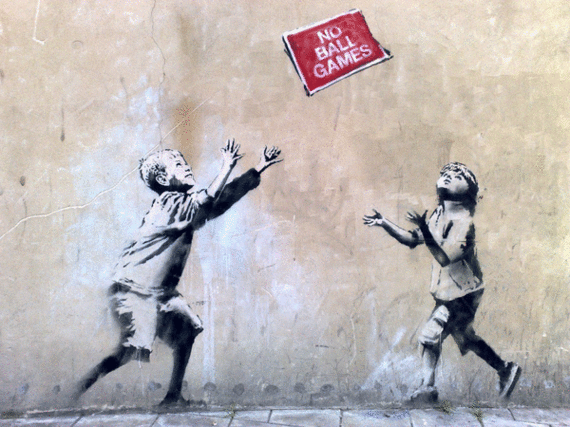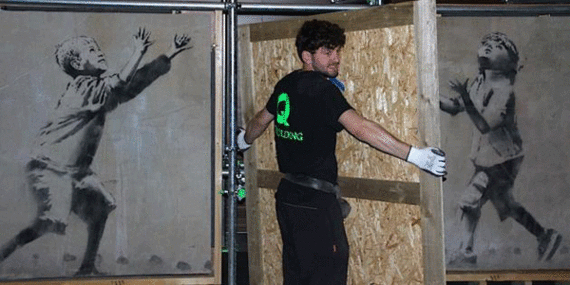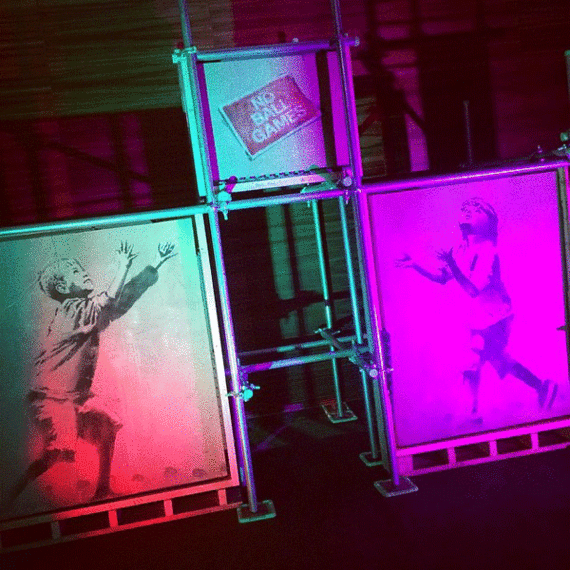This week the UK based company Sincura Group runs is launching 'Stealing Banksy - an exhibition and sale of what is rumoured to be the 'most expensive' collection of outdoor Banksy pieces ever assembled. The works have been removed from buildings and wall surfaces in London, Liverpool and Berlin. While the name sounds like a gentle mockery, the project claims to be quite serious, organised professionally and in transparency.
Company's CEO Tony Baxter justifies 'restoring' and selling Banksy street artworks by pointing out that 'councils make a fuss about preserving them, but often they cause damage by covering them with plastic sheeting'. Sincura assures us that the company does not own the artworks, nor encourage their removal, and if 'assigned to manage a piece of art we ensure the salvage, restoration and sale is carried out in a professional and sympathetic manner.'

No Ball Games, Banksy, Phillip Lane, 2009
It is difficult, however, to accept this attempt to preserve something ephemeral as an act of good will or modern chivalry. Street art in its essence is a creative transient practice. It has as Banksy points out a 'short life span' (Exit Through the Gift Shop), therefore, it is not intended to last, be restored or preserved. It makes its own place in the urban landscape, presented generously as a gift to the local community and the city itself by the artist. Therefore, it seems doubtful that now professionally restored and waiting to be auctioned for profit 'No Ball Games' can have the same impact and effect on emotions as when it was in situ.

No Ball Games on view at Stealing Banksy. Image : Getty

The piece, cut in three, ready to be auctioned.
Here the words of Ben Eine spring to mind, where he shortly explains that
The street work we do is not painted to be sold a few years later. This is the reason I don't sign my street stuff, and like other artists, would never authenticate it - it's not made to be sold, but to be enjoyed... (interview for The Art Newspaper, 2012)
The appearance of uncommissioned street artworks in public urban space challenges the notion of private ownership and spatial politics and in the case with 'Stealing Banksy' seems like it is a subject of speculation. In a recent interview with Caroline Cadwell and RJ Rushmore of Vandalog, Mr Baxter states that
If someone paints graffiti on your wall the council make you remove it or face a £2,000 fine. Yet for Banksy it is different. The building owners never asked for it, they don't want it.
It is true that often street artworks by Banksy are subject to a different attitude. Both local authorities and residents are very careful and would often chose to preserve rather than remove from its environment and that is not because the latter risk having ' a grade 2 listing applied to their premises which seriously affects business operations and resale value', as explained by Mr. Baxter. It is due to the realisation that the works have accrued fiscal value and can be monetised. At the end of the day
As of anything of value, someone will want it and someone is always ready to make profit -that's life. (Eine, The Art Newspaper, 2012)
Mr. Baxter might be surprised to know that while graffiti management policy is currently being revised, local UK councils have developed graffiti management strategies and practices, put in place to recognise and respond to property owners' concern about having uncommissioned work /graffiti on their premises. Residents can file a request for removal with their local council and once the form is officially logged in the system, the council is responsible for the removal in three days period. Councils' graffiti removal policy includes cleaning/removal service for free (check Hackney Council website for example) and is a valid solution for those building owners who are no willing to keep the work on their walls.
Removing works from their natural urban environment to be then sold in a silent auction is problematic on a few levels. Such practice counterbalance the gradual commercialisation of the illicit form as a genre, by creating an artificial hype that collecting works that are meant to solely exist as part of the urban landscape, is the new way of collecting street art

I Can't Believe You Morons Actually Buy This Shit, Banksy, 2007
It also contradicts the democratic and non-authoritative nature of street art, which asks for no mediators to communicate and emotionally engage with its spectators (viewers). Therefore, auctioning the street artworks cannot guarantee in any way their further existence in the public domain as promised by Sincura. They will become private property and will not be freely accessible for anyone to enjoy.
'Stealing Banksy' also raises issues around artists moral and intellectual rights. Part of Banksy's unique creative practice lies with his very Duchampian attitude (great artists of tomorrow will go underground) and his choice to adopt and adapt the mainstream art business strategies such as creating and selling authorised versions of his work, and in signed limited editions... exhibiting in galleries and curating (Lydiate, 2010), without a gallery representation.
Because of this choice to place work, uncommissioned on property, Banksy is often denied the relief of copyright protection and his beautiful public site pieces end up in private auctions such as 'Stealing Banksy. Copyright might be for losers but morally the visual artist's right of attribution and integrity should be always respected.
It is important to see beyond the speculations that Banksy's works are elitist because they are collected by celebrities and re-sold at prestigious auction houses for substantial prices. He still uses the urban landscape as his canvas and generously gits local communities and he does no ask for a £20 entry ticket. All it takes to see the work is actually look closely...
Imagine a city where graffiti wasn't illegal, a city where everybody could draw whatever they liked. Where every street was awash with a million colours and little phrases. Where standing at a bus stop was never boring. A city that felt like a party where everyone was invited, not just the estate agents and barons of big business. Image a city like that and stop leaning against the wall - it's wet...
Banksy, Wall and Piece